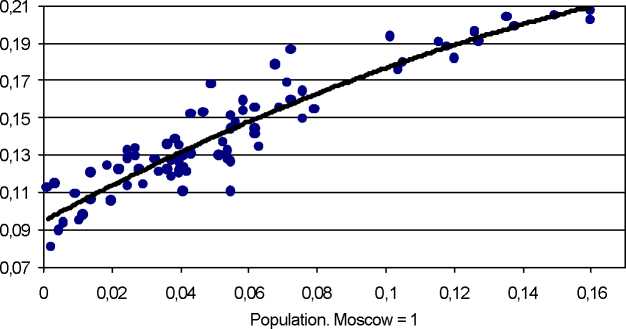and Design Institute for Town Planning, Carnegie Moscow Center). Each of the capitals of
constituent members of the Russian Federation shown on Figure 1 is evaluated individually
(Figure 1)iii.
Some conclusions and key trends
This part focuses on a development potential of the cities which are the capitals of constituent
members of the Russian Federation.
Figure 1. Development Potential of Russian Cities

The 13 „million-cities“, judging by the development potential, form the group of the most
significant Russian cities (among them Moscow, St. Petersburg, N. Novgorod, Yekaterinburg,
Omsk, Novosibirsk, Samara, Kazan, Cheliabinsk, Ufa, Rostov on Don, Volgograd, Perm), as
well as other large cities, such as Krasnoyarsk, Vladivostok, Voronezh, Saratov, Irkutsk,
Khabarovsk (all of them are the centres of the administrative regions of the Russian
Federation) and Togliatti on the Volga (the large centre of motor-car construction). All of
these 20 cities have a large, international or All-Russian significance and through a relatively
intense development have become sharply defined by market economy factors.
In this regard it becomes especially interesting to analyse the development potential of large
cities (with a population over 100,000) and in the first place of the two largest cities of the
country - Moscow and St. Petersburg. Generally it is safe to say that Russia like the former
Soviet Union (Harris 1970) is a land of large cities. The number of cities of more than
500,000 residents in Russia increased rapidly since 1970 from 17 to 33 (Russian Statistical
Year-Book 2000).
More intriguing information
1. Female Empowerment: Impact of a Commitment Savings Product in the Philippines2. The name is absent
3. The name is absent
4. The name is absent
5. The name is absent
6. Applications of Evolutionary Economic Geography
7. Convergence in TFP among Italian Regions - Panel Unit Roots with Heterogeneity and Cross Sectional Dependence
8. The name is absent
9. Ultrametric Distance in Syntax
10. Expectation Formation and Endogenous Fluctuations in Aggregate Demand